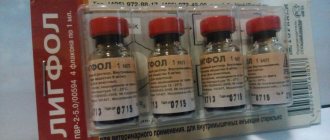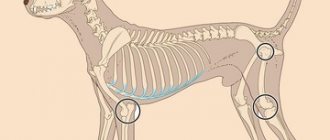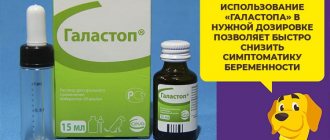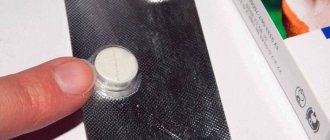Dexafort is a hormonal anti-inflammatory drug. The medicine, which is a type of glucocorticosteroid, was developed by the Dutch company Intervet, but is now successfully used by veterinarians all over the world. Since Dexafort has contraindications, before using it to treat dogs, you must carefully study the instructions for use.
Appearance, composition and storage conditions
The white suspension is intended for injection. It is packaged in glass bottles with a capacity of 50 ml. To maintain the tightness, glass containers are sealed with rubber stoppers and rolled up with aluminum lids.
Elimination of inflammatory processes is provided by two active substances:
- dexamethasone phenylpropionate (1 ml of medicine contains 2.67 mg of this substance);
- dexamethasone sodium phosphate (its content is 1.32 mg per 1 ml).
The action of the active components is similar, but the difference is that dexamethasone sodium phosphate is quickly absorbed and immediately begins to act, but dexamethasone phenylpropionate is absorbed slowly. As a result, the drug begins to work immediately, but has a long-lasting effect.
The solution for injection also includes additional components that perform only an auxiliary function.
Dexafort can be stored for 3 years from the date of production, but subject to simple rules:
- The air temperature should be between 15 and 25˚C.
- Keep away from direct ultraviolet rays.
- The medication cannot be near food or feed.
- Children and animals should not have access to it.
Important! After opening the bottle, the solution can be used only for 28 days. The medicine must then be disposed of.
Properties and principle of operation
The principle of action of Dexafort is based on the fact that its active component is a synthetic analogue of cortisol. Glucocorticosteroid hormone in animals is produced by the adrenal cortex. A special feature of this hormone is its ability to block the production of substances that are involved in inflammatory processes. In addition, the drug stimulates the synthesis of substances that have an anti-edematous effect.
Pharmacological properties include the following:
- has an anti-allergenic effect;
- relieves inflammation;
- eliminates swelling;
- increases cellular immunity;
- has a desensitizing effect, that is, it reduces the body's sensitivity to irritating factors.
When taking the drug, the ability of cell membranes to resist damage increases, thereby achieving anti-shock and antitoxic effects. In addition, vascular permeability decreases, liver cells are activated, which metabolize toxins and harmful substances and promote their removal from the body.
Just an hour after the injection, the concentration of active components in the blood reaches its maximum value. The effect of the drug lasts for a long period - from 30 to 96 hours. Depends on the weight of the animal, the characteristics of the body, and existing pathologies. The components of the drug are excreted through the kidneys and liver.
Dexafort is a moderately dangerous substance, but it is prohibited to use it without a doctor’s prescription.
Release form
The drug is released in hermetically sealed glass bottles of 50.0 cm³.
COMPOSITION AND RELEASE FORM The drug is a transparent, colorless or slightly yellowish liquid. 1.0 cm³ of the drug contains 0.004 g of dexamethasone phosphate, excipients and solvent up to 1.0 cm³. The drug is released in hermetically sealed glass or plastic bottles of 10.0; 20.0; 50.0 and 100.0 cm³. PHARMACOLOGICAL PROPERTIES Dexamethasone phosphate is a fluorinated analogue of hydrocortisone, more active than prednisolone and cortisone. It has a pronounced anti-inflammatory, anti-allergic, anti-edematous and gluconeogenetic effect. The drug blocks the release of inflammatory mediators by eosinophils, including prostaglandins, which are involved in the development of the inflammatory process. Stimulates steroid receptors of lymphocytes, promoting the biosynthesis of lipocortins, which have anti-edematous activity; inhibits the proliferation of lymphoid tissue and cellular immunity, and also disrupts the chemotaxis of T-lymphocytes, reducing their cytotoxic activity. The maximum concentration of dexamethasone in the blood is detected after 60 minutes. Therapeutic concentration in blood serum is maintained for 30-96 hours depending on the type of animal. Bioavailability when administered intramuscularly is 100%. Biotransformation occurs in the liver and partly in fibroblasts involved in the metabolic process. Metabolites are mainly excreted through the liver and kidneys. INDICATIONS The drug is used in animals with metabolic disorders (ketosis and toxemia after birth in ewes and sows); inflammatory processes, especially of the musculoskeletal system (arthritis, periarthritis, tendovaginitis, bursitis, dislocations, myositis, sprains); acute infectious diseases (in combination with antimicrobial agents); allergic conditions (atopic and contact dermatitis, urticaria, itching, conjunctivitis); laminitis in horses and cattle; for snake and insect bites; stressful (exhibitions, training) and shock states. DOSES AND METHOD OF ADMINISTRATION The drug is administered intramuscularly, preferably in the first half of the day: for horses and cattle – 5 cm³; pigs – 2-3 cm³; piglets, dogs – 0.5-1 cm³; cats - 0.25-0.5 cm³ once a day for three days. If necessary, the course of treatment should be continued. In case of infectious diseases, the drug is used only in combination with antimicrobial drugs. SIDE EFFECTS With long-term use, Cushing's syndrome may occur, which causes redistribution of body fat, muscle weakness, weight loss and osteoporosis. Polyuria, polydipsia and polyphagia may occur. The use of corticosteroids in lactating cows may cause a short-term decrease in milk production. In case of hidden infections, the drug may cause their exacerbation. CONTRAINDICATIONS The drug is not used during the last trimester of pregnancy, diabetes, bone fractures, viral and fungal infections. SPECIAL INSTRUCTIONS Slaughter of cattle and pigs for meat is permitted no earlier than after 48 days, horses - after 24 days. Cow's milk can be used for food after 5 days. In case of forced slaughter before the expiration of the waiting period, the meat of animals can be used to feed carnivores. Personal preventive measures When working with the drug, you should follow the rules of personal hygiene and safety precautions. Procedure for filing complaints If complications arise after using the drug, its use is stopped and the consumer contacts the State Veterinary Institution in whose territory it is located. Veterinary specialists of this institution are studying compliance with all rules for using this drug in accordance with the instructions. If a negative effect of the drug on the animal’s body is detected, veterinary specialists take samples in the required quantity for laboratory tests, write a sampling report and send it to the State Institution “Belarusian State Veterinary Center” to confirm compliance with regulatory documents. STORAGE CONDITIONS The drug is stored according to list “B” in the manufacturer’s packaging in a place protected from light at a temperature from 5ºC to 25ºC. The shelf life of the drug is 2 years from the date of manufacture, subject to storage conditions. After opening the bottle, the drug is stored for 28 days.
How much does it cost and where to buy
The price of Dexafort is quite high. One 50 ml bottle costs about 950 rubles, although the cost may vary up or down in different pharmacies. You can buy the medicine at your nearest veterinary pharmacy. Residents of small towns may face the problem of lack of the drug. In this case, you can make a purchase on the Internet, the main thing is to use the services of trusted stores and pharmacies.
You can now view the current price of the drug and buy it right here:
Instructions for use
Injections are made subcutaneously or intramuscularly into the muscle on the thigh. It's the largest muscle, so it's easy to hit. Subcutaneous injections are given in the withers or in the crease under the knee, with the first option being preferable. To make an injection in the withers area, you need to pull the skin with one hand, and with the other, pierce the fold with a syringe needle and slowly inject the medicinal solution.
Inject Dexafort into dogs once in a dose of 0.5-1 ml, depending on their weight. In case of severe disease, the injection is repeated after 7 days. A second injection is possible only after the animal has been examined by a doctor.
special instructions
If inflammation is complicated by a bacterial infection, Dexafort is used together with antibiotics.
To speed up the onset of the therapeutic effect in anaphylactic shock, the medication is used together with anti-allergenic drugs. In some cases, the use of adrenaline is also necessary.
To reduce pain, you can use an insulin syringe with a thin needle. When an injection is given intramuscularly, you need to push the needle about 1.5 cm into the muscle. With deeper penetration, you can hit the bone.
Before drawing the solution into the syringe, be sure to shake the bottle. If you are afraid to give injections to your pet, entrust this to the staff of the veterinary clinic.
Dexafort for dogs
On the website “Dog's House” you are invited to read an article that gives a description of one of the most commonly used drugs by veterinarians, which only makes it possible to understand what it is. Please remember that the information is provided for informational purposes only and is not a guide to action, since advice should only be given by a veterinarian upon personal examination of the animal.
There are other, no less interesting articles on various issues that are directly related to puppies and dogs, and also allow you to understand what you could do in frequently occurring situations and how to properly train them at home on your own.
Dexafort is an antiallergic and anti-inflammatory veterinary drug that relieves swelling and has a desensitizing effect on the body of animals. Manufacturer – Netherlands.
Release form: liquid for injection; dexafort tablets do not exist.
The price for a 50 ml bottle is about 20 dollars. The product is sold in animal pharmacies or ordered online. Cortexone retard is an analogue of dexafort.
According to the instructions, dexafort should be injected into the withers (subcutaneous) or thigh (intramuscular).
Calculation of the dose based on the weight of the dog: - animals under 20 kg are injected with 0.5 ml of the drug; - animals over 20 kg are injected with 1 ml of dexafort.
Dexafort injections are given once. The medicine can be reused only after 7 days.
The effect of Dexafort is felt immediately, absorption of the drug occurs relatively slowly, which ensures a long-lasting effect from the injection. The medicine is excreted from the body by the liver and kidneys.
Possible side effects are polyphagia, polyuria, polydipsia, Cushing's syndrome. Dogs and cats can be injected with Dexafort both intramuscularly and subcutaneously.
Contraindications for use are viral and fungal infections, osteoporosis, diabetes, kidney disease and heart failure.
It is also undesirable to use the medicine during pregnant bitches, as this can cause abortion or premature birth.
Dexafort for dogs with tumors
In practical veterinary medicine, dexafort is indeed used as long-term hormonal therapy when a tumor is detected in a dog, but only a doctor can decide to use dexafort or any other drug.
Contraindications and restrictions
The use of Dexafort for dogs is impossible if the following pathologies are present:
- osteoporosis;
- viral infections;
- hyperadrenocorticism;
- diabetes;
- fungal diseases;
- heart failure;
- stomach or duodenal ulcer;
- corneal ulcer;
- kidney diseases.
In the early stages of pregnancy, the drug is used only in case of emergency, since there is a high risk that it will cause abnormalities in the development of the fetus. The medication is contraindicated in late pregnancy, as it can cause premature birth or miscarriage.
Important! Dexafort should not be used together with vaccines, as it has an immunosuppressive effect.
The drug can reduce the effectiveness of certain medications, so it should only be prescribed by a doctor. Do not self-medicate unless you have a veterinary education!
How to use
Since Dexafort is a suspension that can separate, the contents of the bottle should be shaken well before use. Cats are given injections into the muscles or subcutaneously. Usually one injection is enough, as the drug retains its effect for several days. If the disease is advanced, a second injection may be required after 7 days. Only the doctor should determine the need for a second injection.
The dose of a hormonal anti-inflammatory drug is calculated taking into account the weight of the pet. For each kilogram of weight, only 0.05 ml of suspension is required. If the inflammatory process is complicated by pathogenic bacteria, Dexafort is used in conjunction with antibiotics. Usually the doctor selects a broad-spectrum antibiotic.
Side effects
The use of the drug may cause the following side effects:
- strong thirst;
- excessive food consumption;
- increased urine production.
If the doses and recommendations for use are followed, the medicine rarely causes side effects. With prolonged use or overdose, Cushing's syndrome (hyperadrenocorticism) may develop, which occurs due to increased levels of corticosteroids. In this case, the animal develops the following symptoms:
- weight loss;
- drowsiness;
- osteoporosis;
- muscle weakness;
- frequent urination;
- urinary incontinence;
- increased appetite;
- symmetrical baldness, etc.
If you notice such symptoms, you should seek help from a doctor.
Owner reviews
Tatyana, owner of a 12-year-old fox terrier:
“Despite his age, our dog remains active and cheerful. But something bad happened - I started to itch very much, itching until it bled. The fur on his back was almost completely torn off. After a full examination, it turned out that the itching was caused by a hormonal imbalance. The vet prescribed Dexafort. After the first injection, the dog calmed down, he stopped itching and began to sleep at night. Now we use the drug once a week to prevent the recurrence of the pathology, but Rick tolerates the injections well and has no side effects.”
Maria, owner of the French bulldog:
“My dog has hypersensitivity. The list of factors that can cause allergies is quite large, and it is very difficult to protect your dog from all of them. Itching was often accompanied by baldness and eczema. We tried different methods, but there was no result. The doctor recommended Dexafort. And although I didn’t want to inject the dog with hormones, I didn’t have to regret the decision later. The symptoms were quickly relieved, and after a course of three injections, the fur began to grow back.”
conclusions
Dexafort, in my opinion, is the best glucocorticoid drug. It is a lifesaver for severe itching, when the dog tears the skin until it bleeds and gnaws out the fur in clumps. In this case, you need to quickly relieve acute symptoms, otherwise the condition will be complicated by a bacterial or fungal infection (see the article Fungus in a Dog).
But you need to understand that Dexafort only removes the symptoms, but the root causes remain. Therefore, after injection of the solution, it is necessary to examine and exclude the provoking factor. In most cases, these are various types of allergies (usually flea dermatitis, demodicosis, food, detergents and pet shampoos), less often - autoimmune pathologies.
I do not recommend using Dexafort constantly. Although there are cases when the cause of itching and hair loss cannot be found, and only hormonal treatment helps. But under such circumstances, I prefer to prescribe Prednivet or “human” Prednisolone tablets. You can select their minimum dosage, at which the dog’s condition will be satisfactory and no side effects will occur.










